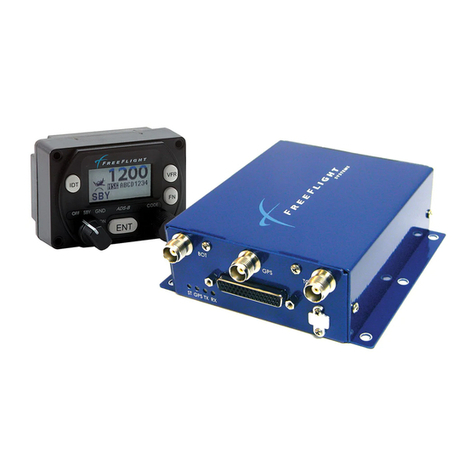
FFS FDL-978 ADS-B EQUIPMENT (P/N 87098-XX-XXXX)
Quick Reference Guide Publication: 87352 Rev B
This document covers the FreeFlight Systems (FFS) FDL-978 ADS-B Transmitter and Transceivers.
The TC978 Controller (right) displays the operating mode of the FDL-
978 ADS-B equipment, reported pressure altitude, current Squawk
Code, and Flight ID. The Reply Indicator (left) is displayed and active
when the FDL-978 ADS-B equipment transmits or receives ADS-B
messages. The pressure altitude is displayed as a Flight Level which
is the pressure altitude in hundreds of feet. The Flight Level shown
may not match the indicated altitude on the altimeter due to non-standard
atmospheric conditions. The display (right) shows the FDL-978 ADS-B Transceiver
equipment powered on, in Airborne Transmission Mode, and with a pressure altitude
of flight level 400.
Control inputs, such as Squawk Code, Call Sign/Flight ID, and mode control (IDENT,
Altitude Inhibit, transmit Standby), are needed by the FDL-978 ADS-B equipment. The
TC978 can provide control input or an external controller (e.g. transponder, display, etc.)
can be configured for use. If an external controller is configured and functional with the
TC978 installed, it displays status, but locks out user control inputs from the TC978.
When in external control mode the TC978 will display the Squawk Code and/or Call Sign
in reverse video (Left).
The Mode Selection knob controls the power to the FDL-978 ADS-B equipment, and the operating mode.
The knob rotates between the different operating modes as listed below.
Power is removed from the FDL-978 ADS-B equipment.
The FDL-978 ADS-B equipment is on, but will not transmit any ADS-B messages.
ALT
The FDL-978 ADS-B equipment automatically switches between Airborne and
Ground Modes. Pressure altitude is reported when Airborne.
ON
The FDL-978 ADS-B equipment automatically switches between Airborne and
Ground. Pressure altitude reporting is suppressed.
There is no functional difference between the two ALT knob positions.
Push Buttons
Press the IDT button when ATC instructs you to “Ident” or “Squawk Ident.”
FN
-Pressing the FN button provides access to changing the Call Sign/Flight ID. You may either directly rotate the
CODE knob or press the ENT button and the first character of the Flight ID will be highlighted. Use the CODE
knob to select your choice of alpha-numeric characters. Press ENT button again and the cursor moves to the
next character. You must press ENT button each time all the way through the eight characters to save your
Call Sign/Flight ID change.
-Pressing the FN button again allows the user to view the FDL-978 ADS-B equipment present position being
transmitted.
-Pressing the FN button again allows the user to adjust the brightness. Rotate the CODE knob to adjust the
brightness to desired level. When the desired brightness is reached, press the FN button to lock the brightness
setting.
-If there are any errors, the fourth press of the FN button allows the user to view the FDL-978 ADS-B
VFR
When the Squawk Code is displayed on the top of the screen, pressing the
button sets the ADS-B to the
pre-programmed VFR Squawk Code. Pressing the VFR button again restores the previous Squawk Code.
When the Call Sign is displayed on the top of the screen, pressing the VFR button sets the ADS-B to the pre-
programmed VFR Call Sign. Pressing the VFR button again restores the previous Call Sign.
The ENT button enters a digit in the code selector.
FreeFlight Systems 2015 ©
3700 Interstate 35 S.
Waco, TX 76706-3756 USA
1 (254) 662-0000




















